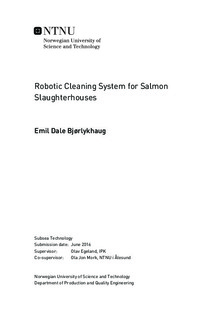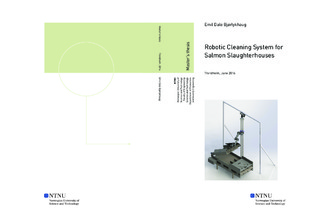| dc.description.abstract | The purpose of this Master's thesis is to look at possible designs for a robotic cleaning solution for salmon slaughterhouses due to the daily need for cleaning and thus high labor costs, and simulate these solutions. In addition, the use of computer vision to aid in such a task is investigated. This thesis is part of a research project that aims at being able to clean a whole slaughterhouse. The focus on this thesis was mainly on cleaning an electric stunner, but many of the challenges with cleaning such a component are transferable to cleaning a whole slaughterhouse.
The main emphasis of this Master's thesis has been on developing different designs for the robotic cleaning solution. Finding a way to move a robot around in a salmon slaughterhouse is a big challenge, and various solutions to this have been developed and investigated. This thesis has both looked at alternatives for the robot, and also looked at smart solutions for the suspension of a robot. Both existing components already on the market have been evaluated, and building certain components from scratch have been investigated. A custom, modular robot have also been designed, with the goal of making a robot that is lighter and has a longer reach than any other robot in its weight class. Some of the designed solutions have been simulated, and it can be concluded that while probably none of the designed solutions will be the final solution when the project is done, some of the designs will greatly influence the next steps for the project. Further work will require trail and error and prototyping to reach a final design.
Another aspect of the robotic cleaning is the robot trajectories. Cleaning is usually performed every day after production has stopped. In order to be able to clean even though a component has been moved, requiring new robot trajectories, computer vision has been tested to see if the position and orientation of components can be established with such an accuracy that the robot trajectories can be updated according to the computer vision data, and resume the cleaning. It can be concluded that computer vision can be accurate enough to calibrate new trajectories if a component is moved, given a good enough sensor. It was also tested to see if computer vision can be used to find unwanted obstacles in the environment. The experiments showed good results, and it can be concluded that unwanted objects can be found as long as they are not too small.
To alleviate some of the problems with manually programming the hundreds of robot commands necessary to clean a whole electric stunner, some time was spent investigating the possibility to generate robot trajectories automatically from a CAD model of the electric stunner. This showed promising results for a simple geometry like a box on a table, but the complex geometries for the components in a salmon slaughterhouse proved to be difficult. Further work would be required to achieve a satisfactory result. | |

